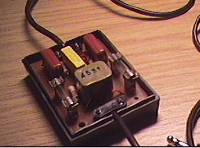Philips recording interface
The first circuit is Philips LFH0117/00 telephone recording adapter,
which is not manufactured anymore I think.
The circuit is quite typical telephone recording adapter design.
I have used succesfully for getting audio from telephone line to soundcard and my stereo system.
The circuit is designed to be connected in parallel with normal telephone.
This circuit does not provide any DC path or correct impedance matching to telephone line
because the telephone provides them
(this circuit is designed so that it disturbs the operation of telephone as little as possible
so it has high impedance input).
 I found out the type of all other components than the transformer T1.
T1 is the audio isolation transformer, which seems to have properties quite similar
to typical 600:600 ohm telecom isolation transformer.
The components F1 and F2 are 50mA fuses.
The signal output level is suitable for microphone input because the resistors attenuate
the voice signals form telephone line around 40 dB
(some telephone equipment regulations in Finland needed this).
On the picture below you can see a picture of the
inside of the Philips LFH0117/00 telephone recording adapter:
I found out the type of all other components than the transformer T1.
T1 is the audio isolation transformer, which seems to have properties quite similar
to typical 600:600 ohm telecom isolation transformer.
The components F1 and F2 are 50mA fuses.
The signal output level is suitable for microphone input because the resistors attenuate
the voice signals form telephone line around 40 dB
(some telephone equipment regulations in Finland needed this).
On the picture below you can see a picture of the
inside of the Philips LFH0117/00 telephone recording adapter:
 In the circuit the two 15nF capacitors are blocking the line DC level and the low frequency for ringing.
All other compnents are safety requirements,
for lowering the noise and for matching the telephone equipment regulations
(signal isolation from line, impedances etc.).
This schematic is basically a very safe one:
fuses are not necessary for proper function (just for extra safety)
and the transformer provides galvanic isolation from telephone line.
The circuit is designed to be connected to the microphone input of a recorder
(the output signal level is typically few millivolts which is too low for any other type of input).
In the circuit the two 15nF capacitors are blocking the line DC level and the low frequency for ringing.
All other compnents are safety requirements,
for lowering the noise and for matching the telephone equipment regulations
(signal isolation from line, impedances etc.).
This schematic is basically a very safe one:
fuses are not necessary for proper function (just for extra safety)
and the transformer provides galvanic isolation from telephone line.
The circuit is designed to be connected to the microphone input of a recorder
(the output signal level is typically few millivolts which is too low for any other type of input).
|